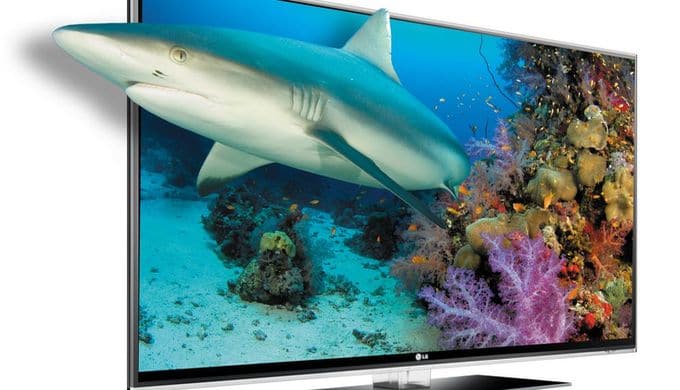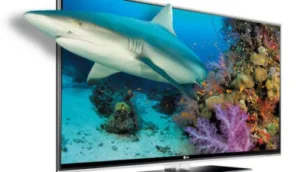A couple of weeks ago, in an introduction to an article, I wrote perhaps it was time to get the menu item for 3D reinstated at the bottom of the front page on Display Daily as the topic seemed to be getting more interesting, again. That introduction got quite a bit of feedback, and I had some questions about why it had been dropped, so I thought it was worth re-visiting the question of the importance of 3D in the display world.

First of all, I am completely (well almost¹) convinced that 3D displays – that is to say displays that give different images to each eye to allow a true sense of image depth, with the associated changes in parallax if the viewer moves their head – will eventually be everywhere. Why is that?
Well, I’ve been in displays for close to four decades and at any point in that time, I have found that most people think that whatever we have at that moment is ‘good enough’. Monochrome text displays were then norm for computers when I started. Graphics and colour were just for special applications such as CAD. Then we got to VGA on the IBM PS/2 and 640 x 480 seemed enough for most.
After watching this happen, I came up with ‘Bob’s Second Law’. (My first law from the 1980s was an observation that ‘Everybody that buys a PC gets another one’. Over the decades, except for illness or failing faculties, I have not met anybody that said ‘I tried this computing thing and I won’t bother again’ although the form factor of the device may have changed). Anyway, Bob’s Second Law is that
“Everything that increases visual bandwidth wins in the end”.
A display is a visual interface into the brain and anything that improves the speed and efficiency of that interface is valuable. On that basis, if you ignore the huge amount of information that the brain derives from a sense of depth, you are simply throwing away information and that goes against the law. So, even though at the time that I realised that (about 20 years ago), there were almost no good or convincing 3D or stereo displays, I knew that eventually we’d get there.
 3D TV Never quite reached the level of the hype
3D TV Never quite reached the level of the hype
In terms of the mass markets, there have been a number of attempts to really drive 3D.
- In the days of CRTs, there were systems that used double refresh rates of the CRTs, with LCD shutter glasses to create stereo images. The gaming CRTs were expensive, the resolution dropped to support higher refresh, the glasses were heavy, expensive and dim and the technology didn’t take off.
- In TV, there was a big push to adopt 3D technologies starting around 2008 and accelerating in 2009. By 2013, we ran a headline “3D TV is “Dead” says HBO Executive”. 3D TV was a nightmare of competing standards, a lack of coordination between display makers and broadcasters and appalling marketing by those that had the best technology. Little surprise, then, that it didn’t take over the market.
- In cinema 3D got some traction and great content made 3D cinema a big trend for a while. Avatar (2009), Life of Pi (2012) and Gravity (2013) were 3D movies that I saw that impressed me. I can’t help but note that a list of the ‘Best 3D films’ on imdb, created in 2017, doesn’t mention any after 2014, and that was a documentary by James Cameron. Cameron is said to have made Avatar 2 and in late 2020, Avatar 3 was said to be ‘95% ready’, but the cinema business is really going to have its work cut out to recover over the next couple of years. 3D cinema has been criticised for being too dim in many theatres and most content has very poor 3D.
- VR headsets. This is developing, slowly, as the first real mass market for stereo 3D. With a headset, the crosstalk between the images to each eye is not an issue. However, headsets are a bit bulky heavy and have limited performance.
So, that’s the negative and the main reason that we dropped 3D as a menu item. However, there are some positive aspects that could enable the development of the technology.
- Resolution support in gaming and GPU power are getting towards the kind of level where there might be ‘enough’ spatial resolution for desktop monitors and most TVs. (Jon Peddie always says “In computer graphics, too much is never enough”) but once you get to a certain level of spatial resolution, the effort can go in elsewhere. For example, in smartphones, although Sony has ‘4K’ devices, others have stayed below that level and concentrated instead on issues such as brightness and colour. You could use the extra power that will become available to drive 3D imaging.
- In TV, the same applies. For most viewers with most TV sizes at most viewing distances, 8K is not really going to show any benefit. However, you could use the bigger number of pixels to deliver different views. The development of 8K displays has allowed the recent development of much better autostereo displays. “More pixels” is always an advantage. However, TV set makers were stung by the failure last time and it will take a while before they are prepared to commit to it again. Broadcasters also have enough to worry about, with 4K, HDR and HFR, although these days if there is a demand for content, it can be delivered via streaming.
- The next potentially big development in cinema is small pitch LED. That will deliver plenty of brightness (maybe too much) to overcome the challenges of dim 3D displays. 3D on an LED cinema could be a really compelling experience and that will be needed to persuade viewers to leave their OLED and QLED TVs to get back to theatres. 3D has usually commanded a premium in theatres, so that could help pay for the LEDs.
- VR and AR will create much more knowledge and technology in creating compelling 3D content. The development of Lidar, for mobile devices as well as for applications such as autonomous vehicles, will mean that there will be more images and videos captured with depth information. Having a really good depth map allows the creation of much better 3D while content is basically captured in 2D. A single content creation process that still allows the creation of good 3D is essential. If you have to develop a separate capture and production process for 3D, it will remain a niche.
Further, there are really genuinely holographic displays that can help to get over the problems of vergence/accommodation conflict and other human factors issues. Systems are being developed that can capture true light fields of scenes to allow the support of holographic displays. Processing systems are becoming available that can deal with the huge amount of data needed to deliver enough image data for great holography and AI will be a big advantage in creating good 3D from 2D with depth maps.
So, it looks as though we may be about to enter a new period of interest and development in 3D, and so, we’ve put the menu item back! (BR)
¹ My only reservation is that I saw some research at one time that suggested that if viewers saw real depth in a relatively small screen, rather than understanding the image as a ‘window on the world’, viewers perceived the scene a real but small objects. In other words, watching, for example a soccer match, the brain sees a small screen as lots of miniature people playing. More research may be needed on this effect. I’m reminded of the story I read a few years ago about two artists who met. One showed the other a photo and said “This is my wife”. The other remarked “She’s very small”. That really highlights the way that we are so used to 2D representations of the world, at different scales, in our culture. (I spent ages googling to try to find the source of this story, but failed. If a reader knows, please let me know!)

